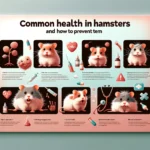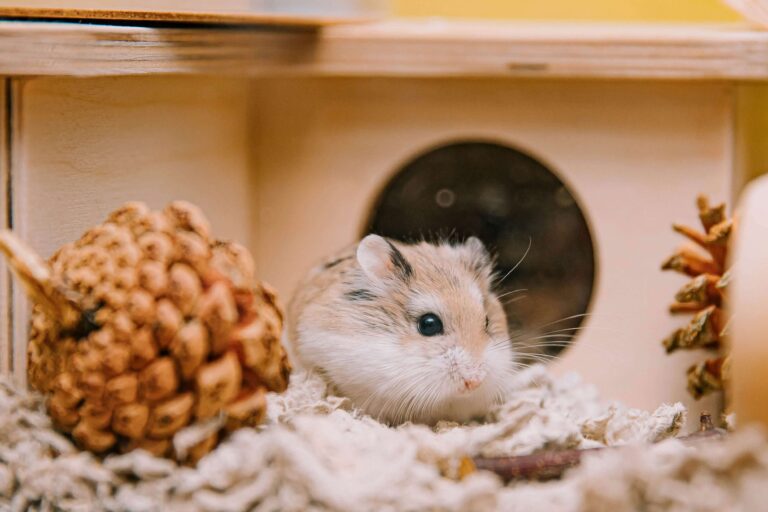Why Hamsters Die – Hamsters.pk
Common Health Issues Leading to Hamster Deaths
Hamsters are beloved pets known for their adorable appearance and playful nature. However, these small rodents are prone to various health issues that can significantly impact their lifespan. As a responsible hamster owner, it is crucial to be aware of the common health problems that can lead to premature death in these tiny companions. In this article, we will discuss the most prevalent health issues that contribute to hamster mortality and how to prevent or treat them.
Respiratory Infections
Respiratory infections are among the most common health problems in hamsters. These infections can be caused by bacteria, viruses, or fungi and are often triggered by poor living conditions, such as inadequate ventilation, high humidity, or exposure to drafts. Symptoms of respiratory infections in hamsters include sneezing, wheezing, discharge from the nose or eyes, and difficulty breathing. If left untreated, respiratory infections can lead to pneumonia, which can be fatal for hamsters.

Digestive Issues
Hamsters have sensitive digestive systems, and digestive issues can arise from various factors, including inappropriate diet, sudden changes in food, or bacterial imbalances in the gut. Common digestive problems in hamsters include diarrhea, constipation, and wet tail, a severe form of diarrhea that can quickly lead to dehydration and death. To prevent digestive issues, it is essential to provide your hamster with a balanced diet, avoid sudden dietary changes, and ensure access to fresh, clean water at all times.
Dental Problems
Like many rodents, hamsters have continuously growing teeth that require constant wear to maintain proper dental health. If a hamster’s teeth become overgrown or misaligned, it can lead to dental problems such as difficulty eating, drooling, and mouth sores. Untreated dental issues can result in malnutrition, weight loss, and even death. Regular dental check-ups and providing appropriate chewing materials can help prevent dental problems in hamsters.
Tumors and Cancer
Unfortunately, tumors and cancer are not uncommon in hamsters, particularly in older individuals. The most common types of tumors in hamsters include mammary tumors, lymphoma, and adrenal gland tumors. Symptoms of tumors and cancer in hamsters may include lumps or swelling, weight loss, lethargy, and changes in behavior. While some tumors can be surgically removed, others may be inoperable or have already spread, leading to a poor prognosis.
Stress-Related Illnesses
Hamsters are sensitive animals that can easily become stressed by changes in their environment or routine. Stress-related illnesses, such as wet tail, can quickly develop and prove fatal if not addressed promptly. Other stress-related health issues include hair loss, weight loss, and a weakened immune system, making hamsters more susceptible to infections and diseases. To minimize stress in your hamster’s life, provide a stable, comfortable living space, maintain a consistent routine, and avoid unnecessary handling or changes in their environment.
By understanding the common health issues that lead to hamster deaths, owners can take proactive steps to prevent or quickly address these problems. Regular check-ups with a veterinarian experienced in small animal care, maintaining a clean and appropriate living environment, and providing a balanced diet are all essential aspects of ensuring your hamster lives a long, healthy life. With proper care and attention, you can help your furry friend avoid these common health pitfalls and enjoy a happy, thriving existence.
Environmental Factors Contributing to Hamster Mortality
Hamsters are sensitive creatures that require a carefully controlled environment to thrive. Unfortunately, many well-meaning owners may unknowingly expose their furry friends to environmental factors that can contribute to illness, stress, and even premature death. In this article, we will explore the various environmental factors that can negatively impact hamster health and lifespan, and discuss how to create a safe and comfortable living space for these beloved pets.
Improper Cage Size and Setup
One of the most significant environmental factors contributing to hamster mortality is an improper cage size and setup. Hamsters need ample space to exercise, explore, and engage in natural behaviors such as burrowing and foraging. A cage that is too small or lacks appropriate accessories can lead to stress, obesity, and a host of health issues. To ensure your hamster’s well-being, provide a spacious, multi-level cage with plenty of bedding, hiding spots, and enrichment toys.
Temperature Extremes
Hamsters are sensitive to temperature extremes and can quickly succumb to heat stress or cold exposure. The ideal temperature range for hamsters is between 65°F and 75°F (18°C to 24°C). Temperatures above 80°F (27°C) can cause heatstroke, while temperatures below 60°F (15°C) can lead to hypothermia. To maintain a stable temperature, keep your hamster’s cage away from direct sunlight, drafts, and air conditioning vents, and consider using a thermometer to monitor the ambient temperature.
Poor Air Quality and Ventilation
Poor air quality and ventilation can have severe consequences for hamster health. Ammonia buildup from urine and feces can irritate a hamster’s respiratory system, leading to infections and breathing difficulties. Additionally, airborne dust and debris from bedding or food can cause allergic reactions and exacerbate respiratory issues. To promote good air quality, clean your hamster’s cage regularly, use dust-free bedding, and ensure the room has adequate ventilation.
Inappropriate Bedding Materials
The choice of bedding materials can significantly impact a hamster’s health and well-being. Some bedding types, such as cedar and pine shavings, contain aromatic oils that can cause respiratory irritation and even liver damage in hamsters. Other materials, like fluffy bedding or cotton, can pose a risk of entanglement or intestinal blockage if ingested. Opt for safe, absorbent bedding materials such as paper-based or aspen shavings, and avoid any bedding with strong odors or harmful additives.
Inadequate Lighting and Sleep Disruption
Hamsters are crepuscular animals, meaning they are most active during dawn and dusk. Exposure to inadequate lighting or sleep disruption can disrupt their natural circadian rhythms, leading to stress and potential health issues. Ensure your hamster’s cage is located in a room with a consistent light-dark cycle, and avoid placing the cage in areas with excessive noise or activity during their natural sleep times. If necessary, consider using a dim night light to simulate natural lighting conditions.
Overcrowding and Social Stress
While some hamster species can coexist peacefully in pairs or small groups, others are solitary by nature and may experience social stress when housed together. Syrian hamsters, in particular, are highly territorial and should always be kept in individual cages to prevent fighting and injury. Even for social species like dwarf hamsters, overcrowding can lead to stress, aggression, and the rapid spread of illness. Always research your hamster’s specific social needs and provide appropriate living arrangements to minimize stress and conflict.
By recognizing and addressing these environmental factors, hamster owners can significantly reduce the risk of premature death and improve their pets’ overall quality of life. Regular cage maintenance, appropriate accessory selection, and close monitoring of temperature, humidity, and lighting conditions are all essential aspects of creating a safe and healthy environment for these delicate creatures. With a well-designed living space and attentive care, your hamster can thrive and enjoy a long, happy life by your side.
Dietary Mistakes That Can Shorten a Hamster’s Lifespan
A balanced and appropriate diet is crucial for maintaining the health and longevity of pet hamsters. However, many well-intentioned owners may inadvertently make dietary mistakes that can lead to nutrient deficiencies, obesity, and a host of health issues. In this article, we will discuss the most common dietary mistakes that can shorten a hamster’s lifespan and provide guidance on how to ensure your furry friend receives the nutrition they need to thrive.
Recognizing Signs of Illness and Aging in Hamsters
As cherished members of our families, hamsters deserve the best possible care throughout their lives. To provide this care, it is essential for owners to be able to recognize signs of illness and aging in their furry companions. By detecting potential health issues early on, you can seek prompt veterinary attention and improve your hamster’s chances of recovery or quality of life in their senior years. In this article, we will discuss the key signs of illness and aging in hamsters and how to respond to these changes.
Changes in Appetite and Weight
One of the most noticeable signs of illness or aging in hamsters is a change in appetite and weight. If your hamster suddenly loses interest in food or begins to lose weight rapidly, it may be a sign of an underlying health issue such as dental problems, digestive disorders, or even cancer. On the other hand, an older hamster may naturally eat less due to a slowed metabolism. Keep track of your hamster’s weight and food intake, and consult with a veterinarian if you notice any significant changes.
Alterations in Activity Level and Behavior
Hamsters are typically active and curious creatures, especially during their natural waking hours. If your hamster becomes lethargic, unresponsive, or displays a sudden change in behavior, it may be a sign of illness or pain. Age-related changes in activity level are also common, with older hamsters often becoming less energetic and more interested in sleeping. However, if your senior hamster appears to be in distress or discomfort, it is essential to have them evaluated by a veterinarian.
Respiratory Distress and Discharge

Respiratory issues are common in hamsters and can be a sign of illness or age-related decline. Symptoms of respiratory distress include labored breathing, wheezing, sneezing, and discharge from the nose or eyes. These signs may indicate a viral or bacterial infection, allergies, or even heart disease in older hamsters. If you notice any of these symptoms, it is crucial to seek veterinary care promptly, as respiratory problems can quickly become life-threatening.
Skin and Coat Changes
A healthy hamster should have a smooth, shiny coat and clean, unblemished skin. Signs of illness or aging can manifest as changes in skin and coat condition, such as hair loss, dryness, flakiness, or the appearance of lumps or sores. These changes may be due to hormonal imbalances, parasitic infestations, or age-related skin thinning. Regular grooming and check-ups can help you detect these issues early on and allow for prompt treatment.
Mobility and Balance Issues
As hamsters age, they may develop mobility and balance issues due to arthritis, muscle weakness, or neurological disorders. You may notice your hamster moving more slowly, stumbling, or appearing uncoordinated. Providing a senior-friendly habitat with low-entry access to food, water, and sleeping areas can help your aging hamster navigate their environment more easily. If mobility issues seem to be causing pain or distress, consult with a veterinarian for appropriate treatment options.
Dental Problems and Drooling
Dental problems are common in hamsters and can be a sign of illness or aging. Overgrown teeth, tooth fractures, or gum infections can cause difficulty eating, drooling, and weight loss. Regular dental check-ups and providing appropriate chewing materials can help prevent and detect dental issues. If you notice any signs of dental problems, seek veterinary care to prevent malnutrition and further complications.
By familiarizing yourself with these signs of illness and aging in hamsters, you can take proactive steps to ensure your furry friend receives the care they need throughout their life. Regular check-ups with a veterinarian experienced in small animal care, along with close monitoring of your hamster’s behavior and condition, can help you detect potential health issues early on. With prompt attention and appropriate care, you can help your hamster enjoy a comfortable and happy life, even in their senior years.
Overfeeding and Obesity
One of the most prevalent dietary mistakes among hamster owners is overfeeding, which can lead to obesity and its associated health risks. Hamsters have small stomachs and high metabolisms, requiring a diet that is nutrient-dense but not excessive in calories. Overweight hamsters are more prone to diabetes, heart disease, and joint problems, all of which can significantly reduce their lifespan. To prevent obesity, offer your hamster a balanced commercial food mix in appropriate portions, and limit treats to occasional rewards.
Inadequate Variety and Nutrient Balance
Hamsters require a diverse and balanced diet to meet their nutritional needs. Feeding your hamster a single type of food or an unbalanced mix can lead to nutrient deficiencies and health problems. A proper hamster diet should consist of a high-quality commercial food mix containing a variety of grains, seeds, and dried vegetables, supplemented with fresh fruits and vegetables in moderation. Avoid relying solely on seed mixes, as these are often high in fat and low in essential nutrients.
Excessive Sugary and Fatty Treats
While it’s tempting to spoil your hamster with sugary and fatty treats, doing so can have serious consequences for their health. Treats like yogurt drops, honey sticks, and seed bars are often loaded with unhealthy sugars and fats that can contribute to obesity, diabetes, and dental issues. Instead, opt for healthy, natural treats such as small pieces of fresh fruits and vegetables, or occasional mealworms for protein. Remember, treats should make up no more than 10% of your hamster’s total diet.
Neglecting Fresh Water
Fresh, clean water is essential for maintaining your hamster’s health and preventing dehydration. Neglecting to provide a constant supply of water or failing to clean and refill water bottles regularly can lead to serious health issues and even death. Ensure your hamster always has access to a clean water bottle or bowl, and check the water level and cleanliness daily. If using a water bottle, be sure to test the spout regularly to ensure proper functioning.
Sudden Dietary Changes
Hamsters have sensitive digestive systems, and sudden changes in their diet can cause gastrointestinal upset, diarrhea, and even wet tail, a potentially fatal condition. When introducing new foods or switching brands, do so gradually over a period of several days to allow your hamster’s digestive system to adapt. If you notice any signs of digestive distress, such as loose stools or loss of appetite, consult with a veterinarian experienced in small animal care.
Feeding Unsafe or Toxic Foods
Some foods that are safe for humans can be toxic or harmful to hamsters. Examples include chocolate, caffeine, alcohol, onions, garlic, and raw beans. Other foods, such as citrus fruits and tomatoes, can be fed in moderation but may cause digestive upset if given in excess. Always research the safety and appropriateness of any new food before offering it to your hamster, and stick to a diet primarily composed of commercial hamster food and safe, fresh produce.
By avoiding these common dietary mistakes and providing a balanced, species-appropriate diet, you can help ensure your hamster lives a long, healthy life. Regular check-ups with a veterinarian, along with close monitoring of your hamster’s weight, appetite, and overall condition, can help catch any potential dietary issues early on. With proper nutrition and care, your furry companion can thrive and bring joy to your life for years to come.










